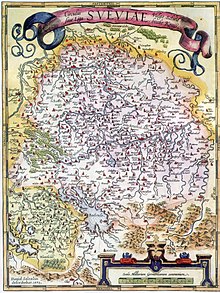Zirkarie Schwaben
The Circaria Swabia ( lat. Circaria Sueviae ) was an administrative district of the Premonstratensian Order that existed from around the end of the 12th century until the secularization of 1806 .
history
In the heyday of the order at the end of the Middle Ages, there were twenty-three zircarias in Europe, seven of them in Central Europe that had existed for centuries: Bavaria, Saxony, Ilfeld (Harz), Wadgassen (Saar), Burgundy , Lorraine and Swabia . The Swabian Circarie had an average of a dozen monasteries and at times even had 26 religious branches. The zirkarie not only included male monasteries, but also double monasteries and nunneries. Since the number of monasteries in the zircarias, which were probably built at the end of the 12th century, increased steadily, districts that had become too large were divided. At the beginning, the Swabian Circarie also included monasteries in Franconia , Bavaria and Tyrol , which were later spun off. Since affiliation to the Circaria often changed and thus the area of its extent also varied, only examples can be given here.
In addition to Ursberg (1125–1803), Rot an der Rot (1126–1803) and Schussenried (1183–1803), the Swabian district also included monasteries further away such as Sankt Luzi in Chur (1140–1806) or Sankt Jakob im Prättigau (1208– 1525). From the 15th to the 17th century, the Bavarian and Swabian circarians jointly organized the annual visits by the two circulators. Most of the time the Abbots of Rot were entrusted with this task, such as Abbot Martin Ehrmann von Zell, who had been a visitor since 1575. From 1616 the provincial assemblies of the Circarie Swabians were often held in red. Since the abbot, from whose monastery new monasteries had been founded, had the right to visit these settlements regardless of who belonged to the circaria, visits to other circarias sometimes led to unpleasant overlaps with the activities of the circators there.
Occasional circariate conferences were held, to which representatives from all associated monasteries were sent. Circular chapter resolutions were passed such as that of 1684, with which the address "Father" was established for the priests of the Premonstratensian Order.
literature
- Volker Himmelein (ed.): Old monasteries, new masters. The secularization in the German southwest 1803. Large state exhibition Baden-Württemberg 2003 . Thorbecke, Ostfildern 2003, ISBN 3-7995-0212-2 , (exhibition catalog and essay volume)
- Franz Quarthal: When Swabia was ruled from Austria. On the history of the Habsburg possessions in southwest Germany. In: Beautiful Swabia. 10/11, No. 6, 1996, ISSN 0931-2323 , pp. 34-39.
- Otto Beck: The Swabian Circarie of the Premonstratensians. In: Hubert Kohler (ed.): Bad Schussenried. History of an Upper Swabian monastery town, Sigmaringen 1983, pp. 9–28
- Catholic Parish Office Rot an der Rot (Ed.): Rot an der Rot. Its history and its two churches. Ottobeuren 1979
- Bernd Martin Rohde, Ulrich G. Leinsle: Documents on the history of the Swabian Circary 1791-1795 in the copy book of P. Innozenz Bamberger von Weissenau . In: Analecta Praemonstratensia, T. 86 (2010), pp. 235-271. (Partial edition of the manuscript Central and University Library Lucerne Pp.254.4 °).
Web links
- The Premonstratensians in the German Southwest; Weingarten 2001 ( Memento from November 4, 2005 in the Internet Archive ) (PDF; 100 kB)
- Entry to Zirkarie on Order online
